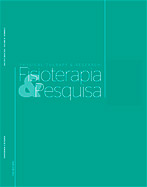Peak cough flow in children and young people with spinal muscular atrophy type II and type III
DOI:
https://doi.org/10.1590/1809-2950/18002025042018Keywords:
Spinal Muscular Atrophy, Expiratory Peak Flow, CoughAbstract
Spinal muscular atrophy is a neurodegenerative disorder, which may be associated with progressive respiratory failure. Our aim is to describe the peak cough flow of children and young people with spinal muscular atrophy types II and III. This is a descriptive, cross-sectional study conducted at a neuropediatrics outpatient clinic between March 2011 and May 2012, with patients with spinal muscular atrophy types II and III, and aging more than 5 years. Out of the 53 eligible patients, 21 participated in the research. The measurement of peak cough flow was carried out through the peak flow meter, with patients sitting and lying down. After taking three measures, we selected the one with the highest value among them. Type-III individuals reached peak cough flow values higher than those of type-II individuals. Measures taken in the sitting position (SMA II 159.4 l/min; SMA III 287.9 l/min) were higher than those measured in the lying position (SMA II 146.9 l/min; SMA III 257.5 l/min), with significant difference (p-value=0.008 in sitting position, and p=0.033 in lying position). We concluded that individuals with SMA III manifest higher PCF, especially when sitting, in comparison with SMA II.
Downloads
References
Araújo AP, Ramos VG, Cabello PH. Dificuldades diagnósticas na
atrofia muscular espinhal. Arq Neuropsiquiatr. 2005;63(1):145-9.
doi: 10.1590/S0004-282X2005000100026
Russman BS. Spinal muscular atrophy: clinical classifications
and disease heterogeneity. J Child Neurol. 2007;22(8):946-51.
doi: 10.1177/0883073807305673
Swoboda KJ, Prior TW, Scott CB, McNaught TP, Wride MC, Reyna
SP, et al. Natural history of denervation in SMA: relation to age,
SMN2 copy number, and function. Ann Neurol. 2005;57(5):704-12.
doi: 10.1002/ana.20473
Wang CH, Finkel RS, Bertini ES, Schroth M, Simonds A, Wong
B, et al. Consensus statement for standard of care in spinal
muscular atrophy. J Child Neurol. 2007;22(8):1027-49. doi:
1177/0883073807305788
Markowitz JA, Singh P, Darras BT. Spinal muscular atrophy: a
clinical and research update. Pediatr Neurol. 2012;46(1):1-12.
doi: 10.1016/j.pediatrneurol.2011.09.001
Kang SW. Pulmonary rehabilitation in patients with
neuromuscular disease. Yonsei Med J. 2006;47(3):307-14.
doi: 10.3349/ymj.2006.47.3.307
Ross BB, Gramiak R, Rahn H. Physical dynamics of the
cough mechanism. J Appl Physiol. 1955;8(3):264-8.
doi: 10.1152/jappl.1955.8.3.264
Evans JN, Jaeger MJ. Mechanical aspects of coughing.
Pneumonologie. 1975;152(4):253-7.
Sharma GD. Pulmonary function testing in neuromuscular
disorders. Pediatrics. 2009;123(Suppl 4):S219-21.
doi: 10.1542/peds.2008-2952D
Freitas FS, Parreira VF, Ibiapina CC. Aplicação clínica do pico de
fluxo da tosse: uma revisão de literatura. Fisioter Mov Curitiba.
;23(3):495-502. doi: 10.1590/S0103-51502010000300016
King M, Brock G, Lundell C. Clearance of mucus by
simulated cough. J Appl Physiol. 1985;58(6):1776-82.
doi: 10.1152/jappl.1985.58.6.1776
Iannaccone ST. Modern management of spinal muscular atrophy. J
Child Neurol. 2007;22(8):974-8. doi: 10.1177/0883073807305670
Gozal D. Pulmonary manifestations of neuromuscular disease
with special reference to Duchenne muscular dystrophy and
spinal muscular atrophy. Pediatr Pulmonol. 2000 Feb;29(2):141-
doi: 10.1002/(SICI)1099-0496(200002)29:23.0.CO;2-Y
Chung BH, Wong VC, Ip P. Spinal muscular atrophy: survival
pattern and functional status. Pediatrics. 2004;114(5):e548-53.
doi: 10.1542/peds.2004-0668
Chatwin M, Bush A, Simonds AK. Outcome of goal-directed noninvasive ventilation and mechanical insufflation/exsufflation in
spinal muscular atrophy type I. Arch Dis Child. 2011;96(5):426-32.
doi: 10.1136/adc.2009.177832
Salam A, Tilluckdharry L, Amoateng-Adjepong Y,
Manthous CA. Neurologic status, cough, secretions and
extubation outcomes. Int Care Med. 2004;30(7):1334-9.
doi: 10.1007/s00134-004-2231-7
Mier-Jedrzejowicz A, Brophy C, Green M. Respiratory muscle
weakness during upper respiratory tract infections. Am Rev
Respir Dis. 1988;138(1):5-7. doi: 10.1164/ajrccm/138.1.5
Ishikawa Y, Bach JR, Komaroff E, Miura T, JacksonParekh R. Cough augmentation in Duchenne muscular
dystrophy. Am J Phys Med Rehabil. 2008;87(9):726-30.
doi: 10.1097/PHM.0b013e31817f99a8
Bach JR. Management of patients with neuromuscular disease.
Philadelphia: Hanley & Belfus; 2004. 350 p.
Bach JR, Ishikawa Y, Kim H. Prevention of pulmonary morbidity
for patients with Duchenne muscular dystrophy. Chest. 1997
Oct;112(4):1024-8. doi: 10.1378/chest.112.4.1024
Suárez AA, Pessolano FA, Monteiro SG, Ferreyra G, Capria ME,
Mesa L, et al. Peak flow and peak cough flow in the evaluation
of expiratory muscle weakness and bulbar impairment in
patients with neuromuscular disease. Am J Phys Med Rehabil.
;81(7):506-11. doi: 10.1097/00002060-200207000-00007
Pereira CAC, Jansen JM, Barreto SSM, Marinho J, Sulmonett
N, Dias RM, et al. Espirometria. J Pneumol. 2002;28(Suppl.
:S1-82.
Miller MR, Hankinson J, Brusasco V, Burgos F, Casaburi R,
Coates A, et al. Standardisation of spirometry. Eur Respir J.
;26(2):319-38. doi: 10.1183/09031936.05.00034805
Bach JR, Saporito LR. Criteria for extubation and tracheostomy
tube removal for patients with ventilatory failure: a
different approach to weaning. Chest. 1996;110(6):1566-71.
doi: 10.1378/chest.110.6.1566
Bianchi C, Baiardi P. Cough peak flows: standard values for
children and adolescents. Am J Phys Med Rehabil. 2008;87:461-7.
doi: 10.1097/PHM.0b013e318174e4c7
Kang SW, Kang YS, Moon JH, Yoo TW. Assisted cough
and pulmonary compliance in patients with Duchenne
muscular dystrophy. Yonsei Med J. 2005;46(2):233-8. doi:
3349/ymj.2005.46.2.233
Summerhill EM, El-Sameed YA, Glidden TJ, McCool FD.
Monitoring recovery from diaphragm paralysis with ultrasound.
Chest. 2008 Mar;133(3):737-43. doi: 10.1378/chest.07-2200
Fromageot C, Lofaso F, Annane D, Falaize L, Lejaille
M, Clair B, et al. Supine fall in lung volumes in the
assessment of diaphragmatic weakness in neuromuscular
disorders. Arch Phys Med Rehabil. 2001;82(1):123-8.
doi: 10.1053/apmr.2001.18053
Marques TB, Neves JC, Portes LA, Salge JM, Zanoteli E, Reed
UC. Air stacking: effects on pulmonary function in patients
with spinal muscular atrophy and in patients with congenital
muscular dystrophy. J Bras Pneumol. 2014;40(5):528-34. doi:
1590/S1806-37132014000500009
Jeong J, Yoo W. Effects of air stacking on pulmonary function
and peak cough flow in patients with cervical spinal cord injury.
J Phys Ther Sci. 2015;27(6):1951-2. doi: 10.1589/jpts.27.1951
Oskoui M, Kaufmann P. Spinal muscular atrophy.
Neurotherapeutics. 2008;5(4):499-506. doi: 10.1016/
j.nurt.2008.08.007
Swoboda KJ, Kissel JT, Crawford TO, Bromberg MB, Acsadi
G, D’Anjou G, et al. Perspectives on clinical trials in spinal
muscular atrophy. J Child Neurol. 2007;22(8):957-66. doi:
1177%2F0883073807305665
Downloads
Published
Issue
Section
License
Copyright (c) 2018 Fisioterapia e Pesquisa

This work is licensed under a Creative Commons Attribution-ShareAlike 4.0 International License.



